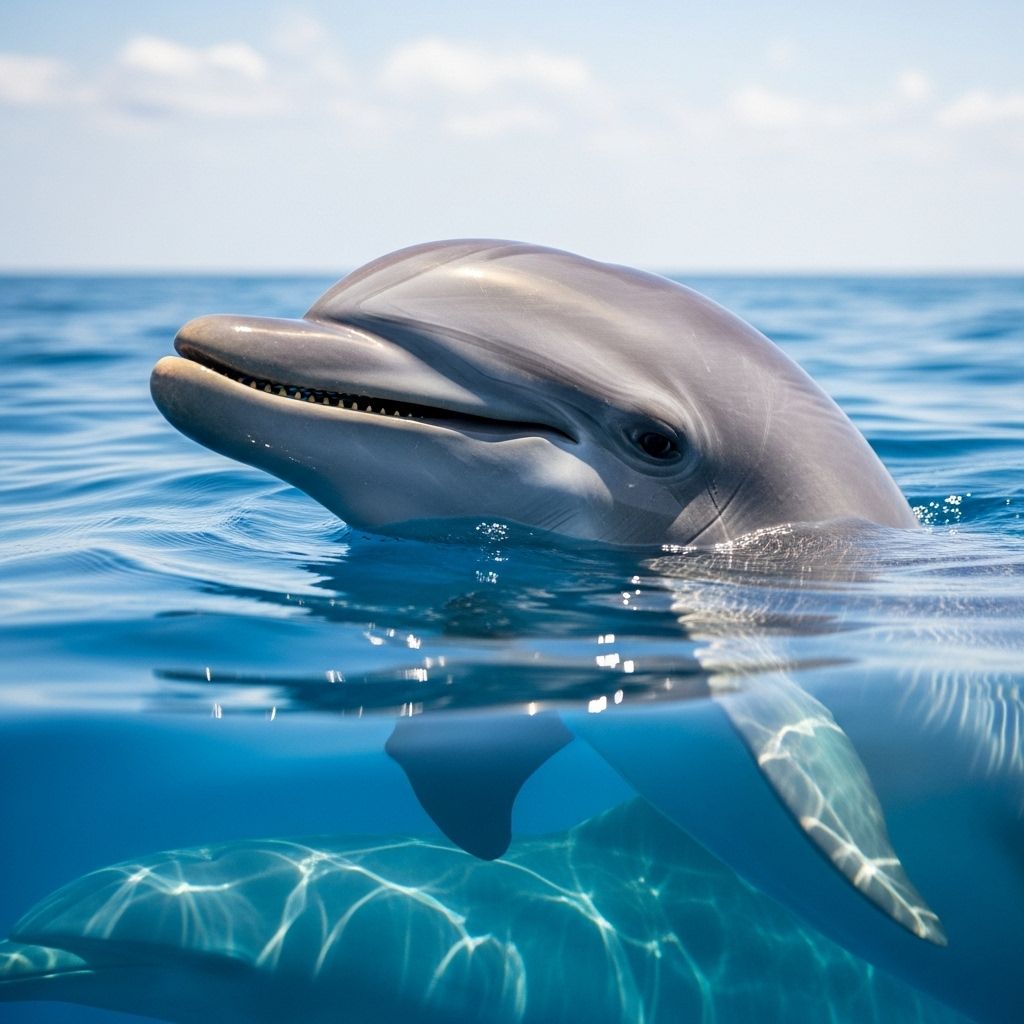Dolphin’s Smile Misconceptions: 5 Well-Being Indicators
True marine mammal welfare emerges through natural behaviors, vocal cues and social play.

The Dolphin’s Smile: Nature’s Most Misunderstood Expression
If you’ve ever seen a dolphin, you probably noticed their unmistakable upturned mouths. This perpetual “smile” has enchanted millions and fueled the popularity of dolphins in aquariums, marine parks, and popular culture worldwide. But is the smile truly a sign of happiness? Or could it be one of nature’s greatest illusions?
Why Do Dolphins Appear to Smile?
Bottlenose dolphins (Tursiops truncatus) and their close relatives possess facial anatomy that gives an impression of constant happiness—a fixed, upturned mouth reminiscent of a human grin. For decades, this image shaped our understanding of dolphin well-being, leading to deep emotional connections between humans and these marine mammals.
But recent research pushes us to look beyond appearances.
The Science of Dolphin Facial Expressions
- Open-mouth behavior: Dolphins display an open mouth as part of their social interactions, especially in playful or friendly contexts. Studies show this is not a random gesture but a signal of playfulness, much like a human laughing face or a dog’s play bow. About 90% of these expressions happen when another dolphin is watching, and the gesture is often mirrored back, suggesting rapid, social mimicry and sophistication.
- Visual communication: Dolphins use these facial displays alongside acoustic signals to communicate intent—friendliness, fun, or a desire to play.
- Universal sign of play: Similar play faces are seen in primates, dogs, and other social mammals, indicating deep evolutionary roots for this kind of non-verbal communication.
So, while dolphins do “smile” at each other during play, the appearance of a smile in captive dolphins, especially those performing in shows, may not reflect true emotional content or well-being.
Anthropomorphism: The Human Tendency to See Ourselves in Dolphins
Humans have a compelling urge to anthropomorphize—projecting our own emotions, intentions, and social structures onto animals we admire or interact with. The dolphin is a prime target given its expressive face and demonstrated intelligence.
- Mistaken signals: Many animals have facial anatomy that can be misread—hippopotamus faces, for example, look friendly but hide aggression. Dolphins’ anatomy creates a permanent smile that can wildly mislead our interpretations.
- Cultural impact: Dolphins are portrayed as gentle, joyful companions in media, advertising, and entertainment, reinforcing the illusion of contentment regardless of their actual situation.
While scientists caution against excessive anthropomorphism, recent studies do support the idea that open-mouth behaviors among dolphins serve genuine social functions and can be analogous, though not identical, to human smiles during friendly or playful exchanges.
The Dolphin Smile in Captivity: Illusion Versus Reality
Marine parks and aquariums have long exploited the dolphin’s smile. Captive dolphins are featured in shows, commercials, and encounters where their expression suggests happiness, comfort, and health. But can we trust what we see?
Table: The Dolphin Smile – Captivity Versus Wild Contexts
| Context | Smile Interpretation | Scientific Findings |
|---|---|---|
| Wild (Play) | Sign of playfulness; social engagement | Often mirrored between dolphins, associated with friendly intent, genuine social bonding |
| Captivity (Shows) | Perceived as happiness or enjoyment | Anatomically fixed; may not reflect emotional state, can mask stress or discomfort |
| Captivity (Stress/Illness) | Smile persists regardless of health | Fixed mouth shape offers no reliable insight into welfare, can lead to misinterpretation |
The Ethical Debate: Should Dolphins Be Kept in Captivity?
- Welfare concerns: Numerous organizations and researchers highlight the stress, limited space, and unnatural social structures faced by captive dolphins. The smile makes it easy for visitors to assume dolphins are thriving, even when conditions are poor.
- Misleading signals: The combination of the anatomical smile and show routines creates a massive gap between actual and perceived welfare. Audiences often leave with the impression dolphins love performing, when scientific studies repeatedly show signs of stress and boredom among captive individuals.
- Education versus entertainment: While some facilities promote education on dolphin biology and conservation, critics argue that entertainment value—centered on the smile—remains the dominant driver, detracting from genuine awareness.
How to Tell If a Dolphin Is Truly Happy?
Genuine dolphin happiness is not reliably indicated by the smile alone. Experts use other indicators to assess welfare:
- High activity levels and curiosity
- Regular, voluntary social interaction
- Vocalizations associated with play and excitement
- Absence of stereotypic (repetitive, purposeless) behaviors
- Evidence of healthy, natural feeding and breeding behavior
Behavioral research shows that the richest, most complex dolphin behaviors occur in the wild, where individuals are free to form dynamic social groups, hunt, and explore a vast environment. Captive dolphins often show more limited, repetitive behaviors that reflect their environment rather than their mood.
The Big Picture: The Smile’s Ripple Effect on Conservation and Human-Dolphin Relationships
The illusion of the dolphin’s smile touches everything from marine policy and conservation funding to individual choices about aquariums, travel, and ethical tourism.
Conservation Efforts Shaped by the Smile
- Funding: Charismatic species like dolphins attract significant public attention—and money—for conservation, largely thanks to the emotional impact of their perceived “happy” nature.
- Mixed messages: The prevalence of captive dolphins in entertainment can weaken support for wild populations facing habitat loss, pollution, entanglement, and hunting.
Human-Dolphin Bond: A Blessing and a Curse
- The smile fosters empathy and excitement towards dolphins, driving support for research and protection.
- The same illusion can also encourage complacency regarding captive welfare, maintain demand for dolphin shows, and perpetuate misconceptions about marine mammal needs.
Frequently Asked Questions (FAQs)
Q: Do dolphins smile because they are happy?
A: Their upturned mouth is an anatomical feature, not an emotional indicator. Scientists have found that dolphins do show a genuine play “smile” during social interactions, but in captivity or stressful contexts, the smile may not reflect true happiness.
Q: Can humans accurately read dolphin emotions from their facial expressions?
A: Not always. Visual signals like the open-mouth play face are meaningful primarily to other dolphins in correct social contexts. Human interpretations are prone to error and often influenced by anthropomorphism.
Q: What signals other than the smile indicate dolphin well-being?
A: Researchers look for natural behavior such as playfulness, curiosity, healthy social interactions, regular vocalizations, and absence of repetitive stress behaviors.
Q: Is captivity harmful to dolphins?
A: Many experts and advocacy groups argue captivity can be extremely harmful due to isolation, restricted movement, and social and psychological stress—especially when facilities rely on the smile to suggest wellness.
Q: How do dolphins communicate besides smiling?
A: Dolphins use a mix of vocalizations (clicks, whistles), body postures, underwater touch, and facial signals to convey intent and emotion to other dolphins.
What Can You Do?
- Support responsible tourism. Choose dolphin encounters that observe animals in the wild, rather than in captivity.
- Educate yourself. Seek out information from marine biologists and reputable organizations about dolphin welfare and communication.
- Advocate for conservation. Support policies and charities that work to protect dolphins in their natural habitats.
- Ask critical questions. Challenge yourself and others to look past superficial signals like the smile and consider the animal’s broader environment.
Conclusion: More Than Just a Smile
The dolphin’s smile, beloved and iconic, is a complex part of both animal behavior and human psychology. While it plays a real role in dolphin social life, its deeper significance lies in how humans interpret—and sometimes misinterpret—what the smile means for the animal’s welfare. Our challenge is to honor the mystery and majesty of dolphins without letting illusions cloud our judgment or actions.
References
- https://www.iflscience.com/were-not-imagining-it-dolphins-really-do-smile-when-playing-with-friends-76206
- https://www.sciencenews.org/article/dolphins-smiling-during-play
- https://www.sciencealert.com/dolphins-may-actually-smile-at-one-another-for-the-same-reasons-we-do
- https://www.sci.news/biology/bottlenose-dolphin-smiling-13313.html
- https://timesofindia.indiatimes.com/etimes/trending/its-true-dolphins-smile-like-humans-while-playing-with-their-mates/articleshow/114042039.cms
Read full bio of Srija Burman












